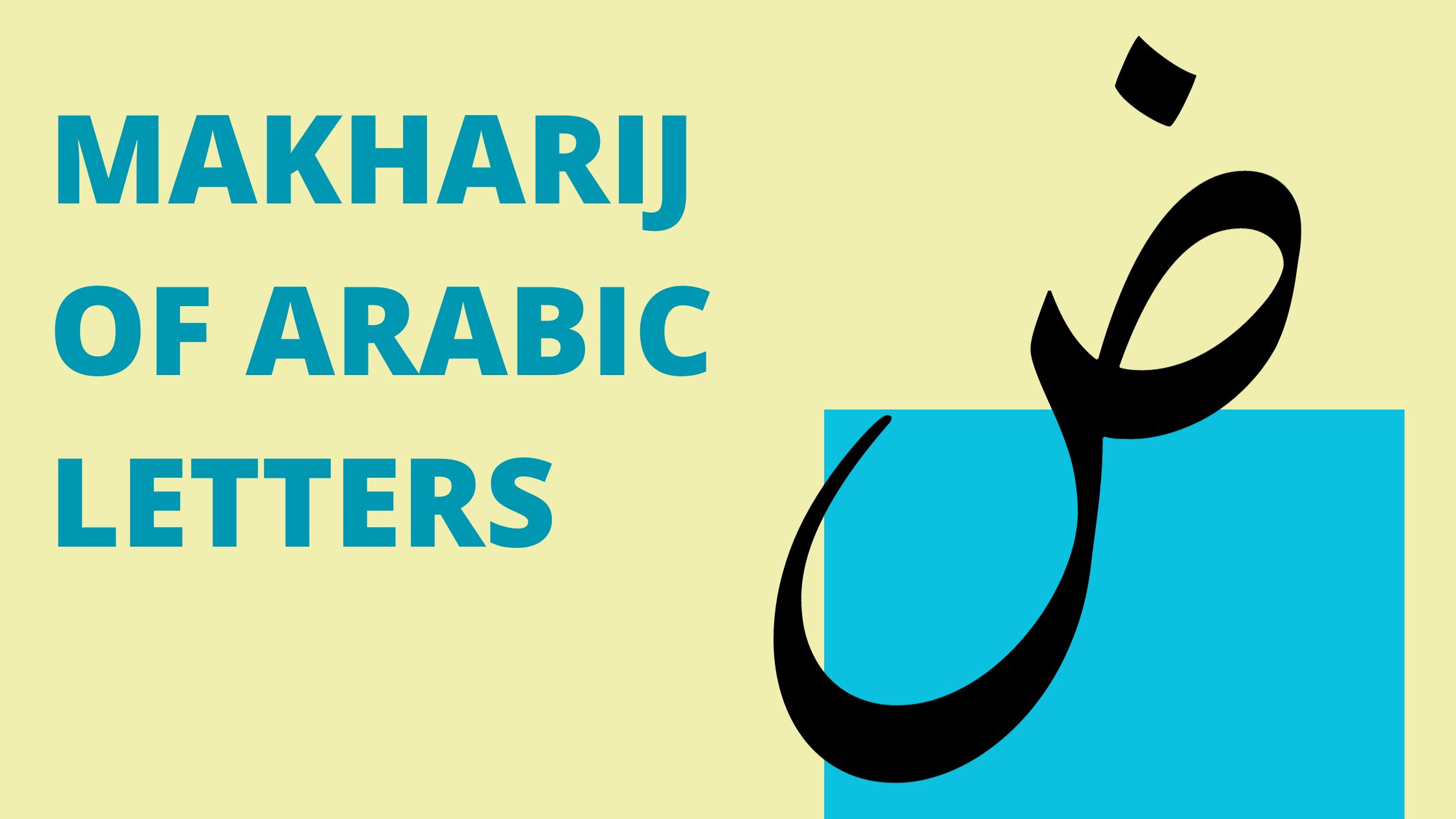In this blog post, we will explore the definition, types, and examples of Makharij of Arabic letters in Tajweed. This will give you a better understanding of this important aspect of beautiful Quranic recitation.
A fundamental aspect of Tajweed is mastering the articulation points of Arabic letters. These points, called “Makharij,” are crucial for accurately pronouncing and enunciating the Quran. Let’s embark on this journey together to discover the fascinating world of Makharij Al Huroof!
Table of Contents
Definition of Makharij al-Huroof?
Makharij al-Huroof refers to the science of the articulation points of Arabic letters. In Arabic phonetics and pronunciation (Tajweed), understanding the “Makharij al-Huroof” is crucial for accurately producing the sounds of each letter. “Makharij” (مخارج) translates to “points of articulation,” and “Huroof” (حروف) means “letters.”
The concept involves identifying and mastering the specific places in the mouth, throat, or lips where each Arabic letter originates. Proper pronunciation is vital for clear and accurate recitation of the Quran and other Arabic texts.
What Are The Points of Articulation in Tajweed?
Tajweed involves paying attention to each letter, word, and verse to recite them accurately and beautifully. One crucial aspect of Tajweed is comprehending the points of articulation.
Definition: Articulation points, also known as Makharij, are specific places within the vocal tract where different Arabic letters are pronounced.
Significance: Understanding and mastering these articulation points is crucial for proper recitation of the Quran.
Foundation of Tajweed: These points form the foundation of Tajweed rules and help ensure that each letter is pronounced correctly with its distinct characteristics.
How to Identify Articulation Points (Makharij)?
A. Vocal Tract: To accurately pronounce Arabic letters, it is important to identify and articulate from the correct point within our vocal tract.
B. Various Parts: The chest area (al-jawf), throat (al-halq), tongue (al-lisaan), lips (al-shafatain), nasal cavity (al-khayshoom), and other intermediary articulation points are utilized.
C. Sound Production: Recognizing specific locations and how sounds are produced helps learners develop clarity in their pronunciation while reciting verses from the Quran.
The Five Main Makharij: Articulation Points of Arabic Letters in Tajweed
The five main Makharij, also known as articulation points, play a crucial role in correctly pronouncing Arabic letters in Tajweed. Each letter has a specific exit point within the vocal system that contributes to its distinct sound and proper enunciation. The following are the five main Makharij.
First: Articulation Points (Makharij) in the Chest Area (al-Jawf)
The jawf, or the empty space in the mouth and throat, is one of the articulation points in Tajweed. When pronouncing letters from the jawf, the tongue remains relaxed at the bottom of the mouth, allowing air to flow freely from inside the body out of the mouth.
A. Letters Pronounced from the Jawf
Alif (ا) sakin with a fatha before it: The letter Alif is pronounced by allowing air to flow freely from the chest area without any involvement of the tongue. It is typically preceded by a fatha diacritic.
Wow (و) sakin with a dhammah before it: Similar to alif, this letter is produced without the use of the tongue. The airflow passes through the jawf, creating the sound of “oo.” It is commonly preceded by a dhammah diacritic.
Yaa (ي) sakin with a kasrah before it: The pronunciation of yaa from the jawf involves the same process as alif and wow. The sound of “ee” is produced by the airflow through the chest area. It is often preceded by a kasrah diacritic.
B. Sound Production from the Jawf
When pronouncing letters from the jawf, the tongue does not play a role in shaping the sound. Instead, the sound is produced solely through the airflow passing through the empty space in the mouth and throat. This allows for a distinct and clear pronunciation of alif, wow, and yaa.
Second: Articulation Points (Makharij) in the Throat (al-Halq)
The throat, also known as al-Halq, is a significant point of articulation in Tajweed. It is located in the upper part of the neck and is responsible for producing sounds by constricting or releasing air through it. It is divided into three parts as follows:
A. Aqsa al-Halq
Definition: Aqsa al-Halq refers to the lowest part of the throat, which is located closest to the chest.
Letters from this makhraj: The letters pronounced from this articulation point are ء (Hamza) and ه (Haa).
Pronunciation: When pronouncing these letters, the airflow is constricted at the lowest part of the throat, creating a distinct sound.
B. Wasat al-Halq
Definition: Wasat al-halq refers to the middle part of the throat.
Letters from this makhraj: The letters pronounced from this articulation point are ع (‘ayn) and ح (Ha).
Pronunciation: When pronouncing these letters, the airflow is constricted at the middle part of the throat, resulting in a unique sound.
C. Adna al-Halq
Definition: Adna al-Halq refers to the highest part of the throat.
Letters from this makhraj: The letters pronounced from this articulation point are غ (Ghayn) and خ (Kha).
Pronunciation: When pronouncing these letters, the airflow is constricted at the highest part of the throat, producing a distinct sound.
Third: Articulation Points (Makharij) in The Tongue (Al-Lisaan)
The tongue, which refers to the organ in the mouth used for speech, is one of the main points of articulation in Tajweed. It has various positions within the mouth that are used to pronounce different letters, as follows:
A. The Furthest Back Part of the Tongue
Definition: The furthest back part of the tongue has two letters.
Letters from this makhraj: ق (Qaf) and ك (Kaf).
Pronunciation: When pronouncing ق, the extreme back of the tongue touches the upper palate, creating a thick sound in the tonsils area.
For ك, the tongue does not meet the upper palate, except as necessary for pronunciation, resulting in a sound produced from the back of the tongue without elevation.
B. The Middle of the Tongue
Definition: The middle part of the tongue is used for three letters.
Letters from this makhraj: ش (Shin), ج (Jim), and ي (Ya).
Pronunciation: These letters are pronounced when the middle part of the tongue contacts the roof of the mouth opposite to it.
C. The Side of the Tongue
Definition: The side of the tongue has two specific points of articulation.
Letters from this makhraj: ض (Dad) and ل (Lam).
Pronunciation: For the letter ض, the rear side of the tongue touches the upper back teeth from either the right side, the left side, or both. The left side of the tongue is commonly used.
The letter ل is articulated by the side of the tongue nearest the front of the mouth and the tip of the tongue touching specific areas of the gums and teeth.
D. The Tip of the Tongue
Definition: The tip of the tongue has five articulation points for eleven letters
Letters from this makhraj:
ن (Noon), ر (Ra), د (Dal), ط (Taa), ت (Ta), ص (Sad), س (Seen), ز (Zaay), ظ (Za), ذ (Dhal), ث (Tha)
Pronunciation: Each letter has a specific point of contact with the tip of the tongue and the opposing gums or teeth. The sounds produced vary based on these contact points.
Fourth: Articulation Points (Makharij) in The Lips (Al-Shafatain)
The lips (Al-Shafatain) play a significant role in the articulation of Arabic letters. There are two specific points of articulation within this general region. Let’s explore each of them:
A. Articulation Point with One Lip:
The letter ف (Fa): The letter ف is pronounced by bringing the edge of the upper front teeth in contact with the inside lower lip, specifically the wet part. It involves pressing the upper front teeth against the inner part of the lower lip to produce the sound.
B. Articulation Point with Two Lips:
The letter ب (Ba): To pronounce the letter ب, the lips are pressed together firmly and quickly. It is similar to the letter “b” in English but with more of a bounce. The lips are brought together and then released rapidly to create the sound.
The letter م (Meem): The letter م is pronounced by pressing the dry outer parts of the lips together and pushing air through the nasal passage. It is similar to the letter “m” in English, where the lips meet while air is expelled through the nose.
The letter و (Waw): It’s important to note that this is not the elongated form of “waw” from the jawf. This letter carries harakaat (vowel markings) and is pronounced by the incomplete joining of both lips without them completely meeting. The lips are slightly apart, allowing the sound to pass through with the appropriate vowel sound.
Fifth: Articulation Points (Makharij) in the Nasal Cavity (Al-Khayshoom)
The nasal cavity is a part of the nose located at the farthest point, known as the bridge of the nose. It serves as an opening that connects the mouth to the nose, allowing for the passage of air and sound. This distinct sound is especially noticeable when pronouncing the letters noon (ن) and meem (م) with a shadda (ّ) above them.
A. Ghunnah and its Articulation Point
The ghunnah is a specific sound that is produced in the nasal cavity. It is characterized by resonance and does not involve the use of the tongue. The articulation point for producing the Ghunnah sound is located in the nasal region.
B. Ghunnah in Arabic Phonetics
In Arabic phonetics, the Ghunnah sound is particularly associated with the letters noon (ن) and meem (م). It is more prevalent when these letters have a shaddah, which represents the doubling of the sound.
By understanding the pronunciation of Arabic letters with Tajweed, learners can improve their skills in reciting the Quran with accurate pronunciations that follow Tajweed rules. This ensures clarity and beauty in their practice of recitation.
Benefits of Mastering Articulation Points
- Enhanced Recitation Skills: Mastering the Makharij enhances one’s recitation skills by enabling accurate pronunciation.
- Deepened Connection with Allah’s Words: Accurate communication through precise pronunciation deepens learners’ connection with Allah’s words.
- Appreciation for Arabic Letters: Mastery of articulation points allows learners to appreciate the beauty of every sound in Arabic letters.
- Immersion in Proper Quran Recitation: Proper understanding and application of articulation points enable learners to fully immerse themselves in proper Quran recitation.
Unlock your child’s potential in the language of the Quran with Bayan Al-Quran’s online Arabic learning program for kids.
Importance of Articulation Points in Tajweed
Understanding the importance of articulation points is essential for achieving correct recitation and maintaining the beauty and integrity of Allah’s words. Here are some reasons why articulation points matter in Tajweed:
1. Accurate Pronunciation:
Articulation points help ensure that each letter is pronounced correctly, allowing us to convey the intended meaning of the words accurately.
2. Distinctive Recitation:
Properly identifying and utilizing articulation points helps distinguish between similar-sounding letters, preventing any confusion or misinterpretation while reciting.
3. Aesthetic Appeal:
Mastering articulation points enhances the overall melodiousness and rhythm of our recitation, creating a more enjoyable experience for both ourselves and those listening to us.
By recognizing the significance of articulation points in Tajweed, we can strive to improve our Quranic recitation skills and deepen our connection with Allah’s divine words.
Help Your Child Master Tajweed and Quranic Recitation with Bayan Al-Quran Academy!
At Bayan Al-Quran Academy, we offer the best learning experience of the Quran with Tajweed online for kids. Our online Islamic academy provides one-on-one Quran recitation, memorization, and Tajweed courses for children of all ages and levels.
Our certified tutors from al-Azhar help students develop a strong foundation in Quranic recitation by focusing on proper pronunciation, articulation, and intonation.
Through our meticulously designed courses, children learn step-by-step and receive personalized attention to improve their weak points and excel in their Quranic studies.
We also offer Arabic language and Islamic studies classes to provide a comprehensive learning experience. Start with a free trial and choose the best tutor for your child at Bayan Al-Quran Academy today.
Conclusion
Understanding the articulation points of Arabic letters in Tajweed is crucial for proper recitation of the Quran. The Makharij provides a framework for accurately pronouncing each letter and ensuring clarity in recitation.
By mastering these articulation points, learners can enhance their pronunciation skills and deepen their connection with the divine words of Allah.
At Bayan Al-Quran Academy, we offer comprehensive courses on Tajweed that cater to all levels of proficiency. With our expert instructors and personalized learning approach, your journey toward fluency in Quranic recitation will be both enriching and rewarding.

















